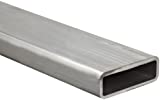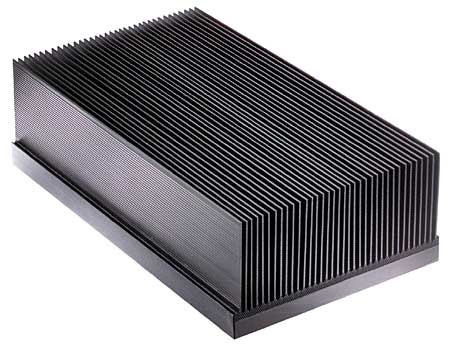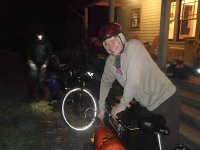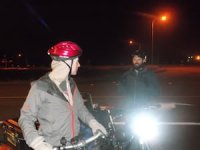The last part of the puzzle was the batteries. In starting this trip, we were each using 4 of the flat-pack 48V 10Ah eZee batteries, 13S 5P of 2200 mAh cells apiece, for 48V and ~42Ah of actual capacity. The edgerunner frame neatly accommodates one battery under the rear deck, but we wanted to move most of the remaining packs up towards the front of the bike to even out the weight a bit. We thought they looked pretty good on either side of the frame, like small gas tanks, but they were wide enough to interfere with our knees while pedalling. So kept moving the mounting point forwards and up until finally there was clearance, but by that point they protruded front of the frame in a goofy manner and were high enough to exacerbate the tippy handling on some already top loaded bikes.
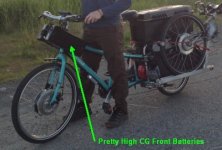
So, when we got through seattle we picked up a front bike rack from REI, and then moved the battery anchors down onto that instead of on the frame. Though I knew the lower CG would be good for handling, I thought it would be a disadvantage having the battery load pivot with the front wheel. To my surprise I found it gave a huge improvement. The extra inertia on the front wheel completely eliminated the low speed front wheel wobbles that were present with the pack on the frame, and it gives some feeling of tank like stability to the whole affair. Hands free riding was certainly not in the cards in the original layout.
View attachment 5
It was also a good way to test out the
twist battery anchors that we'd made for these packs. Our initial designing was based on the idea of the battery sitting horizontally on the rack, and we weren't totally sure just how well they'd hold up with a sideways loaded assembly. There was a little bit of play on one of the packs which would cause a bit of rattle on bumpy roads, so I used a bungee to hold it snug, and with that's it's been quiet and solid.
Anyways, the original plan was not to run four 10Ah packs which is a bit cumbersome, but two custom laid out 20Ah allcell batteries instead. As most of you are familiar, AllCell is a battery assembly operation based in Chicago who use a phase change material between the cells in order to clamp the temperature rise, and in theory the lower peak temperatures should increase the cycle life, and potentially allow the use of the lower cost / whr energy cells rather than the power cells we'd usually spec in an ebike.
We approached them with a healthy dose of scepticism since their marketing material read like the typical over-the-top wonder battery claims, and included life cycle graphs that looked more like they were produced in photoshop than on a lab discharge station. But last year they made us a pack that had the exact same cell layout and cell type as our eZee flat packs, enabling us to do a side by side discharge comparison. And sure enough, on a 2-3C continuos discharge setup, the eZee packs would hit 65oC right in the space between the cells, while the allcell pack with PCM surrouding never went above 45 degrees.
Even more intriguing though was the additional protection and ruggedness that the PCM matrix provides by surrouding all the individual cells. We'd had many problems in the past with heatshrunk batteries mounted to bikes or racks that eventually wore through the heatshrink at contact mounts and in some cases caused a short circuit, and in other cases denting and cracking the cell case. This was especially true with attempts at doing frame mounted batteries in soft bags. But the allcell technique there is a safe buffer of PCM material before any cells are exposed. After cardboard and wooden mockups we came up with this layout for the cells, which could be configured in either a 10S 9P or a 13S 7P layout:
View attachment 1
The cavity on the bottom left is to provide a protected space for the BMS circuitry so that the circuitry sit's flush and isn't vulnerable and protruding through the shrinkwrap, and the the geometry made up such that it should fit inside the small and medium sized
Revelate Tangle Frame Bags and tapered with an acute angle to fit in the front triangle of most bikes OK.
Allcell wasn't quite able to get these packs made in time for our departure, but they did rush them through to get to Wake at TheEbikeStore in Portland so that they showed up during our Portland stay. Scott at AllCell warned that they might look a bit ugly given that it's hard to shrink over a taper, but to us these were things of beauty! First check to see if they fit the tangle bags OK:
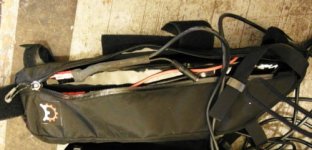
And then more importantly, did they fit in the edgerunner frames? It was tight, but with the downtube cables arranged neatly everything fit just so:
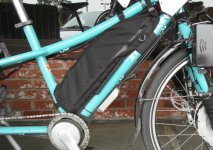
We got three of these packs in total, nominally 48V 17Ah each, and left behind four of the 48V 10Ah eZee packs with Wake. So each bike now has more capacity, and with the weight centered in the frame and no longer taking up cargo space.
 .
. 

